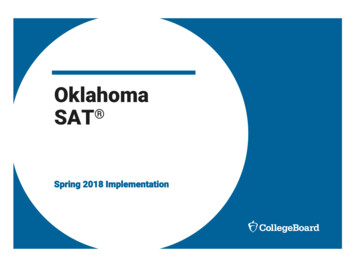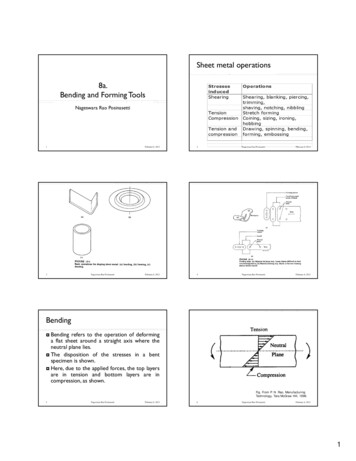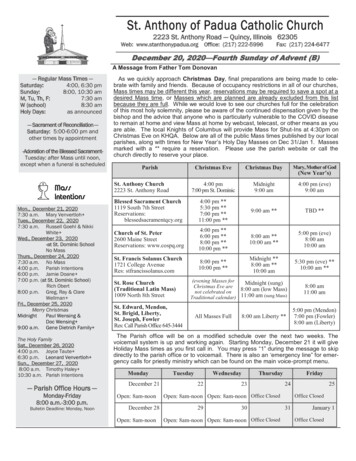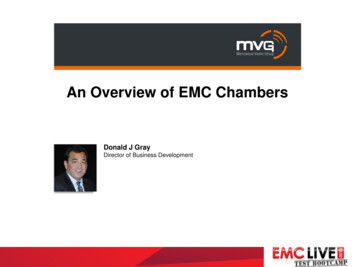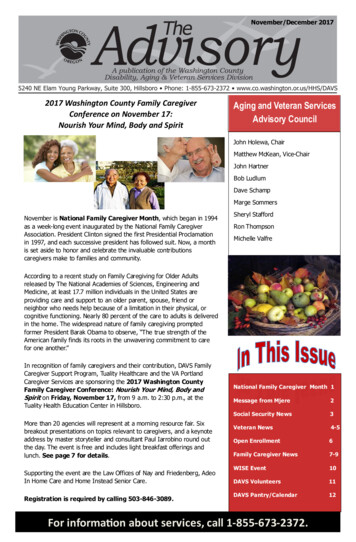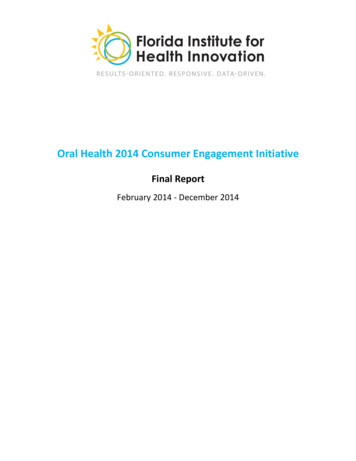
Transcription
Oral Health 2014 Consumer Engagement InitiativeFinal ReportFebruary 2014 - December 2014
Steering CommitteeAlina SotoAmy GuinanAngella WigganAnne SwerlickDouglas ManningErica Floyd ThomasFabio NascimentoJanice SiegelKaren Pesce BuckenheimerGeori BermanLilli CoppMark EverettFlorida Institute for Health InnovationExecutive DirectorRoderick King, MD, MPHProgram ManagerChristine Kovach Hom, LCSWProject CoordinatorDaniella Orihuela, MPH
AcknowledgementsThe Florida Institute for Health Innovation is deeply grateful to the Steering Committee whoseguidance and expertise continue to inform the direction and future of oral care quality anddelivery in South Florida. The Institute would also like to extend a heartfelt thank you to theDentaQuest Foundation for their generous patronage that made this project possible.
Table of ContentsI.Abstract . . .5II.Introduction . .5III.Objectives . . .6IV.Methodology .7A.B.C.Steering CommitteeConsumer Engagement Surveyi.Survey Designii.Sample Selectioniii.Data Collectioniv.Resultsv.Consumer Survey EvaluationFocus Groupi.Selection Processii.Methodsiii.Common Themesiv.EvaluationV.Conclusions . .14VI.Recommendations 15VII.References .16VIII.Appendices. . .17A.B.Consumer Engagement Survey linksConsumer Engagement Data Collection Timeline
AbstractAs part of a comprehensive effort to reduce oral health disparities and to improve the oralhealth of people living in Florida, the Florida Institute for Health Innovation has coordinatedmultiple statewide oral health initiatives. As a grantee of the Dentaquest-funded Oral Health2014 Initiative, a nationwide movement for oral health systems change, the Institute hasfocused on raising oral health awareness and improving access to preventative oral healthcare. In addition to activities on mobilizing medical and dental health providers, FIHI haschosen to pilot an Oral Health Consumer Engagement Initiative that directly engagescommunities served to evaluate care delivery and quality. The Institute hopes to identifybarriers to accessing oral health care in these five Florida counties to inform decision-makingand to assist in establishing a more consumer driven system.IntroductionThe Florida Institute for Health Innovation (FIHI), formerly known as the Florida Public HealthInstitute, is a non-profit, non-governmental organization whose mission is to create healthyand sustainable communities through innovation in public health policy and cross-sectorcollaboration. As one of several sister public health institutes throughout the United States, theInstitute believes that today’s health challenges require a unique way of working based onshared leadership; aligning root causes and strategy and measurable results. FIHI is committedto completing rapid research projects and to promoting a multi-sector systems approach toachieve a positive health impact. A critical analysis of our efforts in achieving these objectivesis instrumental to our future success and desire to broaden our initiative.The Institute is currently one of five southeast regional leaders working with the DentaquestFoundation to facilitate a 12-state regional oral health agent network. FIHI is utilizing itsexpertise to help create connections, foster collaboration, and develop plans of action in orderto align and maximize efforts towards improving oral health around the country. TheInstitute’s prior initiatives in the state of Florida include:I.II.III.Conducting a county analysis of emergency department visits due to preventable dentalconditions for both adults and pediatric patientsConducting qualitative and quantitative research designed to assess oral healthknowledge and skills and care gaps in primary care residents and physiciansLeading the state oral health coalition, Oral Health Florida, through a results-basedstrategic planning process resulting in a statewide roadmap for oral healthThe Pew Center found that 75.5% of Florida’s Medicaid-covered children did not see a dentistin 2011. Further, the Centers for Medicare and Medicaid (CMS), ranked Florida as 50th in theUnited States for the percentage of Medicaid-eligible children who see a dentist in a given year.FIHI found that presented with these statistics is an opportunity and responsibility. Theinstitute seeks to take collaborative action towards identifying and understanding the barriers5
children around the state experience to receiving equitable dental care, and amending thesecauses.Florida ranks 46 out of 50 with a Gini coefficient for income equality of 0.474, displaying alarge income disparity among wage earners in all income categories [1]. Further, Florida is oneof 12 states, according to the Census Bureau, where the majority of minority children underthe age of 10 come from low income families [2]. When income and race or ethnicity arecombined, 40% of black children and 30% of Hispanic children are members of families withincomes below the federal poverty threshold in the state of Florida [3]. While major factorsaffecting dental care could be cost and/or previous bad experiences [4], this is also somethingthat needs to be evaluated at the community level as experience ranges across the state.In preliminary research, various factors were identified as barriers to care-seeking forchildren’s oral health among low-income caregivers. These included perceptions of thetreatment and experiences with the dentist, feeling that the child did not yet need to see thedentist, costs, transportation, and time. These factors were statistically proven in otherresearch to contribute to the poor oral health and low access to dental care among thesechildren, though, factors that have ranked high in the past might not uniformly apply to allcommunities. These barriers were used to develop research tools and included careperceptions, treatment, quality of care and time, transportation and insurance issues.Although due to the variation in experience, tools were developed to allow the inclusion ofother barriers unique to Florida residents.It is important that researchers seek the input of oral health consumers from all communities.Consumers should be extended an invitation to participate in the planning process and toshare their needs, concerns and barriers to care, as well as their suggestions for improvement.FIHI’s Oral Health Consumer Engagement Initiative aims to do this by identifying andunderstanding the oral health needs and opinions of underserved communities around inMiami-Dade the state of Florida and their access to care and to incorporate this consumervoice into their evaluation. FIHI implemented this pilot program in Miami-Dade County. Theprotocol and core objectives were guided by a Steering Committee and network ofstakeholders. The pilot consisted of a consumer engagement survey and focus group.Individuals in underserved communities in South Florida were asked to participate in thesurvey at several childcare centers located in their respective communities. A focus group wasassembled at a childcare center in Miami-Dade County. This was to glean key themes fromindividuals representing these communities, to gain a more in-depth understanding of the oralhealth experiences. The following report details the research strategy for the ConsumerEngagement Initiative, including stakeholder engagement, survey design and development andfocus group methodology and implementation.ObjectivesFIHI’s Oral Health Consumer Engagement Initiative, a component of the DentaQuestFoundation’s Oral Health 2014 deliverables, has two main objectives:6
1) The development of a statewide consumer engagement infrastructure to improve access to,and utilization of, preventative oral health care for Florida’s vulnerable populations.2) The sharing of consumer concerns to decision-making institutions, entities, groups andindividuals throughout the state of Florida.Data gathered throughout this initiative could potentially provide the Institute and the statewith information regarding relevant and useful strategies that will improve the overall healthand well-being of people living in Florida.MethodologyThe following sections explain in detail the three pilot research components: the formation of asteering committee, the development and administration of a consumer survey, and theorganization and facilitation of focus groups around the community.Steering CommitteeBuilding upon the Institute’s collaborative leadership principles, the first step in this initiativewas the establishment of a stakeholder network. This group was selected using a snowballmethod, and intended to include both traditional and non-traditional leaders that had a stronginterest in improving oral health. The result was a diverse group representing variousorganizations and populations around the state of Florida. These included health professionals,community partners, private and public organizations, and universities and colleges and werefacilitated by the Institute’s Program Manager. Committee members collaborativelycontributed their expertise to provide insight on patients’ needs and perspectives duringmonthly conference calls. As a group, they identified indicators of success to advise the designof strategies for change. This process promoted a problem-solving environment built on trustand support; these components are vital in moving the oral health initiative forward. Thecommittee was instrumental in helping the Florida Institute for Health Innovation connectwith the community.Consumer Engagement SurveyA consumer survey targeting families with children covered by Medicaid was proposed as amethod to identify and understand consumer’s perspectives about barriers to accessingand/or utilizing dental care in Florida. The development was informed by existing oral healthsurveys and under the advising of the Steering Committee.Survey DesignThe survey design was guided by successful survey models of health care consumerengagement and vetted through the Steering Committee for revision and input. Survey themes,question format, and objectives were reviewed by committee members. The 23-question7
Consumer Engagement Survey required an estimated 10 minutes to complete. Surveydevelopment took place between February 2014 and April 2014. The final survey link isprovided in Appendix A. The survey contained the following themes, which were adapted fromprevious best practice models: DemographicsBarriers to accessBarriers to utilizationChild's first dental visitSource of oral health informationSatisfaction with dental care receivedInteractions in a dental office settingSurveyMonkey, an online survey development cloud-based tool, was chosen to administer andstore survey entries. Responses were aggregated and participation was voluntary. Thisresearch tool was designed to collect information regarding the caregivers’ demographicinformation, oral health practices, and attitudes. The survey did not collect any informationthat could be traced back to specific respondents, and responses were to remain confidentialand anonymous. The only identifying information was presented in the last question wherecaregivers are asked whether they would like to engage with the Institute in furtherconversation on the topics surveyed; in this instance, their name and contact information wascollected. When this information was provided the survey response was not anonymous to theInstitute, but remained anonymous to the public. This anonymity exception is explained bothat the question description and in the first page within the consent and eligibility description.Due to the large Hispanic/Latino population in Florida, especially South Florida, the SteeringCommittee recommended that the survey be available in both English and Spanish. The ProjectCoordinator was a native Spanish speaker and translated the survey from English to Spanish.FIHI’s Social Media Coordinator was also a native Spanish speaker and served as a proofreaderfor the translation.There was no incentive offered for the completion of the survey. There were also no benefitslisted for the survey participants.Sample SelectionTarget populations for this project were ideally caregivers for children in families covered byMedicaid. However, as with any pilot project, participant recruitment can be difficult.Therefore, data was ultimately gathered from any child caregiver, who was a resident ofFlorida and willing to complete the survey. Members of the Steering Committee played acentral role in suggesting key locations in target communities to collect survey data. Thesewere primarily childcare centers; data was collected during Oral Health team visits from theChild Issues Committee at the Miami Consortium for a Healthier Miami Dade, RedlandsChristian Migrant Association, and health fairs in South Florida neighborhoods.A timeline of survey participant recruitment events may be found in Appendix B.8
Data CollectionTwo methods were used to collect the data for the Consumer Engagement Survey: paperformat or mobile technology/iPad. Participants were asked to choose their preferred method.Mobile technology/iPad allows the data to be instantly saved to the SurveyMonkey onlinedatabase, considerably decreasing data entry time and potential for errors. This tool enabledeasy administration and monitoring of the data, allowing researchers to observe trends asmore data was gathered. Due to the use of technology that may be unfamiliar to surveyrespondents, the Steering Committee also felt that is was important to have an FIHI teammember who was familiar with the survey and the mobile format present at the survey sites toanswer questions or provide explanations. The hope was that participants would be morelikely to complete the survey and enjoy the process, thereby increasing the accuracy andefficacy of the data collected.ResultsThe following data highlights results from the Consumer Engagement Survey. As of December31st, 2014, a total of 65 surveys have been collected and analyzed, 24 in Spanish and 41in English.Demographic statistics revealed the majority of survey respondents came from Miami-County.Participants in the Consumer Engagement Survey were represented as follows: BrevardCounty (1.72%), Broward County (18.96%) and Miami-Dade County (79.31%). Similar to thegeneral population of those counties, a large percentage of the respondents in Miami-DadeCounty were primarily Spanish-speaking as shown in Figure 1.Figure 1: Native Language of Participants by CountyNot all participants provided their race. However, for those who did, participants’ ethnicitywas varied with nearly 45% identifying as Hispanic, 32% as Caucasian, 20% as African9
American or Black and less than 1% as Haitian. A variety of questions were asked to gauge theoral health habits and knowledge of participants. These questions gathered information onwhether participants and/or their children regularly visit the dentist, age of their child’s firstdental visit, frequency of dental visits and barriers to accessing dental care. The data wasparsed by primary language spoken to determine if any further trends are evident.Figures 2 and 3 below show an interesting dichotomy found among the participants in theConsumer Engagement Survey. English-speaking parents/caregivers indicated they saw adentist more regularly than their children (76% versus 54%) whereas Spanish-speakingparents/caregivers saw a dentist less regularly than their children (56% versus 83%). Whenasked why their child didn’t have a dentist, the top responses among English-speakingparents/caregivers were that they could not find a dentist for their child (40%), could find adentist that accepts their dental insurance (30%), or felt that their child did not need a dentist(30%). Among the Spanish-speaking respondents, 67% indicated that their child does nothave dental insurance coverage and 33% reported they could not find a dentist that acceptedtheir insurance. Primary methods for finding a pediatric dentist for both populations includedasking friends and family for referrals. English-speakers also utilized referrals through theirprivate insurance companies whereas Spanish-speakers asked their child’s doctor for areferral or used the Medicaid booklet.Figure 2: Child Regularly Visits DentistFigure 3: Regularly Visit DentistFigures 4 and 5 below depict the age of the participant’s child at the time of their first dentalvisit. Spanish-speaking participants in this survey indicated that they take their child to thedentist much earlier than English-speaking participants. Sixty-five percent of the Spanishspeaking participants had taken their child to the dentist by age two, whereas only 26% ofEnglish-speakers indicated the same.10
Figure 4: First Dental Visit EnglishFigure 5: First Dental Visit SpanishWhen asked to select perceived barriers to care the data revealed that the majority ofresponses were technical or logistics related rather than a dissatisfaction with care or feelingthat dental care was not important. The data suggests that the gap in care is an access-drivenone rather than a lack of education in the community on the importance of dental care.Participants ranked the following factors as barriers to accessing dental care for their child: Need to set appointments months in advance (36.11%)Difficulty in finding a dentist (33.33%)Offices not open on the weekend or after work hours (30.56%)Long waits in the office (27.03%)Dental care costs too much (19.44%)Fear of the dentist (8.57%)Focus GroupEarly in the proposal of this project it became evident that there was a need to have a more indepth conversation with caregivers to understand the barriers they encounter when accessingand utilizing dental care for their children. This dialogue would serve as an opportunity forcaregivers to elaborate on the barriers they face and for the researchers to ask more probingquestions. The Focus Group Guide is available upon request.Selection ProcessParticipants were selected using a snowball sampling strategy combined with participantsuggestions from the Steering Committee, from their network of Oral Health stakeholdersthroughout Florida. A connection with the Children’s Issues Committee at the Consortium for aHealthier Miami Dade offered an introduction to directors at the Liberty Academy Preschool,located in Liberty City, Miami. Liberty City is a predominantly African American community(95%) with a median household income of 18,000 [5]. The administration at the childcarecenter allowed FIHI to use their venue and assisted in the recruitment of parents to participatein a pilot focus group.11
When conducting a focus group it is of utmost importance to create an environment in whichparticipants feel comfortable and safe. This is vital in aiding parents and caregivers to sharetheir perspectives and experiences. A non-threatening environment helps unveil any emotionsor reactions participants might have regarding the discussion topic. Hosting the pilot focusgroup session at Liberty Academy provided a local, well-known venue to welcome parents.The desired focus group participants were parents or caregivers of children aged 0 to 17 years,who were full-time residents of the state of Florida. The pilot focus group at Liberty Academyhad a total of six participants who were parents or caregivers of children aged 1 to 5 years.MethodsThe focus group was led by two FIHI personnel: a facilitator and a recorder. The facilitatoropened discussion and drove the conversation forward using the Focus Group ModeratorGuide. Participants were made aware of the purpose and desired end goals of the discussionand were provided with information on privacy and confidentiality standards. The recorderwas present as a silent observer and assistant to the facilitator. FIHI staff was responsible forensuring all required forms were completed and that all sessions were recorded via audiotape.The target focus group was between 5 -12 participants, with sessions lasting between 45-90minutes. Layout of the room, including chairs and tables, were in a circular arrangement,rather than a classroom instruction setting, to help participants feel more included in theconversation and to establish the facilitator as a guide, rather than an instructor, duringdiscussion. It was explained to participants that no risks greater than those experienced inordinary conversation were anticipated and that their participation was completely voluntary.Data obtained through a focus group is qualitative in nature. It is important to note that theresponses of the participants in the focus group reflected their own personal opinion andexperiences and cannot be applied or interpreted to the population at large. In order to do so,a statistically relevant number of focus groups would need to be conducted.Common ThemesThe following data was collected during the pilot focus group held on October 18th at LibertyAcademy Preschool and evaluated by FIHI for common themes.Focus group participants were very candid and enthusiastic to share their experiences. Thisdemonstrated the benefit and importance of keeping questions open and allowing theparticipants the flexibility to express themselves. All group participants were parents ofchildren attending the Liberty Academy Preschool. Common among their responses was aconsistent consideration of the needs of other parents in their community and how the issue ofdental care access either personally inhibits or enables them in various ways. The groupadditionally considered possible solutions at both the local and state levels. Examples of someof the questions and responses are detailed below. It is important to note that the answershave been paraphrased and are not direct quotes of any particular participant.“Compared to the rest of the body, how would you describe the importance of taking careof your children’s mouth and teeth?” Just as important. Oral health is connected to overall health. Bacteria and plaque,12
for example, can build up and affect the rest of your body functions.“What are some reasons people might not take their children to the dentist?” Work schedules. Many parents work multiple jobs, and even have to work duringthe weekends. It is hard to take time off of work to take children to the dentist,especially multiple days for multiple children. In many cases, children from thesame families are not scheduled for appointments on the same day. Doctors needto look at it as a family unit. It can wait. Some people do not consider oral health as important or might needto work and therefore do not consider taking their child to the dentist a priority.In addition, if the child currently has baby teeth many consider that it can wait."What methods do you use to seek information about oral health?” TV shows. Morning talk shows sometimes have a designated “health day.” Manypeople watch them and can receive basic but important health information. Internet. Ready and available information anytime.“What have been your experiences with dentists who accept Medicaid for your children?” Harder to schedule. Less doctors available who accept Medicaid. Lack of flexibility. Parents feel they have to go through a lot of restrictions andlimitations to receive appropriate care. They advocate that just because they arereceiving this benefit, does not mean that they should “jump through hoops.” Feeling less valued. Parents that felt they had received inappropriate care ortreatment felt they could not complain about it since it was a free service.“If you were in a room full of state decision-makers what would you tell them they need todo to help parents learn about taking care of babies and children’s teeth and preventingdental issues?” Cut the red tape. Increase communication modules; ask the community directlywhat they want. We do not all want to take advantage of the system. Increase pay out for Medicaid. We understand why dentists and physicians arenot inclined to take Medicaid patients, we need to facilitate a system whereeveryone is getting paid for the service they provide. Provide children checkups in school settings. Most parents do not have the time totake their child to the dentist even if they could, if children were screened inchildcare centers or schools then it would alleviate this problem and increasepreventative services.“Do you or does someone you know believe they were treated differently in a dental settingbecause of race, ability to pay, or type of insurance?” Cannot verify or deny. As a minority group, racism is always questioned whenunfair treatment is received, however we try and move past it. Cannot verify ordeny if it is present in a dental setting. Stereotypes are present. Example: gold teeth for African Americans. A fashion13
statement is stereotyped often.EvaluationThe Focus Group supported the findings in the survey that most challenges in seeking dentalcare for children were logistics issues rather than perception or experience related barriers.All participant discussion suggests a more effective way of addressing the gap in oral healthwould be to make care more consumer friendly and adapted to consumer schedules withlifestyle considerations. Further, based on this research, Florida residents do not experiencethe negative treatment documented in other states and are willing to collaboratively approachensuring their children receive dental care. Finally, internet and television based oral healtheducation should be further explored.Consumer Survey EvaluationBased on the exclusion to anonymity of FIHI researchers explained in the consent andeligibility survey description and question 23, FIHI was able to obtain a list of surveyparticipants that provided permission to be contacted. A short four-question customer servicesurvey was designed to evaluate participants’ experience with the Consumer EngagementSurvey. This is a summary of those evaluations completed by parents that attended the focusgroup at Liberty Academy on October 18, 2014. Most participants found the topics interesting,easy to understand, and felt they had the opportunity to share their opinion: ‘Strongly agree’ or‘Agree,’ 4 versus 1 ‘Strongly disagree’ for each of these questions. Similarly, participants feltthe facilitator was effective and professional, that participants, as parents or caregivers, feltthey could make a different by sharing opinions and experiences, and would be will toparticipate in a future focus group: ‘Strongly agree’ or ‘Agree,’ 4 versus 1 ‘Strongly disagree’ foreach of these questions. This demonstrates that participants felt proactive and empowered toaddress gaps in oral health care and displayed a trust for researchers.ConclusionsThis pilot provided great insight that will be used to develop 2015 Consumer Engagementresearch. Key themes were noted throughout such as participants’ willingness to seek dentalcare for their children, cultural differences along language lines, low percentages of individualshaving negative experiences with the dentist, and consistency with where individuals seekinformation about oral health. The goals of future research will be to expand the samplingradius and monitor the trends in data. It will be important to capture the cultural diversity andvariety of experience in the state of Florida to appropriately adapt research tools andprogramming. Participants demonstrated a level of trust and confidence with researchers andan interest in the improvement of oral health delivery.14
RecommendationsCompiled below are recommendations to improve or enhance the Consumer Engagementresearch tools for future programming. Follow-up research will be conducted in 2015. More recruitment and structure in the Steering Committee. The Steering Committeeshould be expanded to include members representing various locations throughout thestate and an even greater diversity in expertise and experience. The structure of theSteering Committee should be revised to include more in-person meetings to enhancedialogue and to enrich committee discussions. Revision of the Consumer Engagement Survey. Researchers found this survey was not, infact, a good medium to evaluate participant feelings. The survey additionally should berevised to more closely correspond to English-speaking versus Spanish-speakingrespondents to further extract differences among the two communities in dental careseeking behaviors. Additionally surveys should be linked to the counties where theywere taken during analysis. Analysis demonstrated variation by location and notabledifferences in care-seeking behavior by community. Questions regarding negativefeelings during dental care visits should be minimized or omitted. This survey revealedhigh levels of satisfaction with treatment and quality of care. Revise research protocol to include quantitative data collection. This could best beachieved during the revision of the survey to include questions that can be coded intovariables and analyzed for demographic statistics and to generate Odds Ratios. Expand data collection plan to include communities around the state of Florida. 2015data should be collected around the state of Florida to compile a true representation ofexperiences and voices from a variety of communities.As research is expanded there should be a greater focus on documenting and then developingprogramming to address the logistical or technical barriers that currently exist. There was anotable difference in Spanish-speaking versus English-speaking responses suggesting researchshould be divided among cultural or language lines to most appropriately capture data.Medicaid payout to dentists should be further reviewed and new media outlets explored fordispe
health of people living in Florida, the Florida Institute for Health Innovation has coordinated multiple statewide oral health initiatives. As a grantee of the Dentaquest-funded Oral Health 2014 Initiative, a nationwide m



